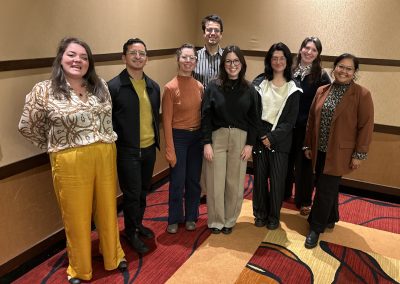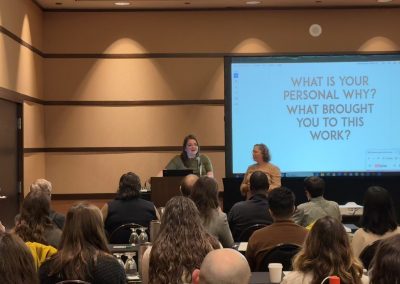Last week, Commute Seattle team members attended the Washington State Ridesharing Organization (WSRO) Conference in Tacoma. The event brought together transportation professionals, Employee Transportation Coordinators (ETCs), and Transportation Demand Management (TDM) implementors from across the state for several days of learning, collaboration, and conversation about the future of sustainable transportation.
Commute Seattle at WSRO
Commute Seattle staff at WSRO 2025. From left: Alex Hudson, Armando Guerrero, Danielle Jacobs, William Khadivi, Anna Smalley, Risa Terry, Tara Peters, and Zarina Infante.
The breakout sessions were especially valuable, highlighting the connection between Transportation Management Associations (TMA’s) like ours and ETCs working directly with commuters. Attendees could choose between two session tracks: one for TDM implementors and one for ETCs. The sessions covered a wide range of topics, from managing complex CTR-affected worksites to launching transit subsidy programs like King County Metro’s ORCA Recovery Card Program.
Read on for the Commute Seattle team’s top takeaways from WSRO 2025!
Creating Space for Understanding
Risa shared that it was helpful to hear from both Employee Transportation Coordinators and Implementers to better understand how our work aligns.
“ Implementor track sessions allowed us to take on ideas for new strategies, learn from the challenges they faced, and strengthen community partnerships. ETC track sessions highlighted the unique stories of ETCs and provided insight into the challenges they face and the tools that are most useful for them. For example, some ETCs may be working with an extremely limited budget or with an employee population with highly variable working hours.” — Risa
Having space to hear directly from ETC’s helps us and other implementors support their work more effectively.
Broadening the Impact of Our Work
One standout session came from the City of Vancouver, which focused on data-driven approaches to transportation. Danielle shared a valuable reminder that our work isn’t just about reducing vehicle miles traveled or cutting greenhouse gas emissions. It’s also about building people’s confidence and desire to use sustainable modes of travel.
“It’s important to measure and understand the outcomes of the work we all do to increase people’s confidence, knowledge, and desire to use sustainable travel options. Knowing which tactics most influence people’s confidence, knowledge, and desire to use sustainable travel modes could make a big difference in positively impacting travel behavior.” — Danielle
When we understand what motivates someone to change how they commute, we can design more effective and meaningful programs.
TDM is Creative Work
Transportation Demand Management is often viewed as technical and policy heavy. And yes, it includes a lot of acronyms: TDM, VMT, CTR, GHG, ETC to name a few! But one of the key messages that emerged from WSRO was that this work is also inherently creative.
In sessions like The Art of Storytelling, led by Commute Seattle executive director Alex Hudson and Move Redmond executive director Kelli Refer, we were reminded that changing travel behavior requires imagination, empathy, and communication.
“We’re helping people imagine another way of living their lives. From coffee for commuter events to increasing parking fees to pay for bike facilities and subsidized transit, all these strategies are seed-planting moments to imagine change. Could you try another mode of travel? What would it take to begin? How does your future self, your family, your neighborhood benefit from this change? We help people believe that yes, another way – and another world — is possible.” — Tara
These creative strategies help people begin to ask questions and imagine new ways of being.
Pilots Prove Low-Barrier Programs are Successful
Zarina shared key takeaways from a presentation on the City of Seattle’s ORCA Recovery Card initiative, which offered free ORCA Passport cards to grocery and food service workers in the Chinatown-International District and Pioneer Square neighborhoods to support front-line workers in response to the COVID-19 pandemic.
This low-barrier program didn’t require employment proof and focused on essential workers, relying on direct, in-person outreach to succeed.
“The program’s success, managed by just one full-time staffer, underscored the urgent need for transit access among low-income workers outside traditional office jobs.” — Zarina
This pilot reinforced a common challenge in transit benefit programs: how to scale successful models without overburdening small businesses.
The Workplace isn’t the Only Place for Transit Pass Access
Having access to convenient and affordable transportation is a big factor for choosing where to live. In addition to long-standing employer pass programs, transit agencies like King County Metro and Community Transit have recently started residential pass programs for multifamily buildings to provide transit passes as an exclusive benefit to residents. In a panel on residential pass programs, Community Transit shared that over 50% of the 20,000 distributed residential transit passes are actively in use. Key to their success is low barrier to entry for properties to participate and creating a time-bound incentive (free unlimited ORCA pass that expires after 30 days) to create a sense of urgency to get more people to try a new mode sooner.
Moving Forward, Together
Across every session, one message came through clearly: partnerships, relationships, and human connection are at the core of effective TDM. Whether through storytelling, data, or direct outreach, the work we do to build trust and provide access is what makes programs succeed.
We left the WSRO conference with new ideas, stronger relationships, and a deeper appreciation for the creativity and collaboration that this work requires. We’re excited to continue the conversations, build on what we learned, and keep working toward a more sustainable, connected, and equitable transportation future for everyone.


